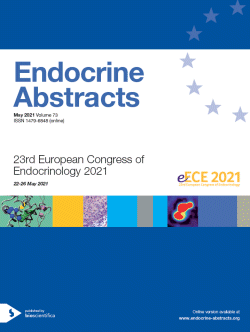
European Congress of Endocrinology 2021
Online
22 May 2021 - 26 May 2021
Presented Eposters
Presented ePosters 15: Late Breaking
ea0073pep15.1 | Presented ePosters 15: Late Breaking | ECE2021
Diabetic euglycemic ketoacidosis in newly diagnosed type 1 diabetes mellitus during A ketogenic diet
Erdogan Beril Turan , Durmaz Himmet , Bestepe Nagihan , Ogmen Berna , Ozdemir Didem , Topaloglu Oya , Ersoy Reyhan , Cakir Bekir
ea0073pep15.2 | Presented ePosters 15: Late Breaking | ECE2021
Monocarboxylate transporter 8 deficiency leads to autophagy-induced persistent cathepsin-mediated thyroglobulin processing triggered by insufficient L-type amino acid transporter 2 functionality
Venugopalan Vaishnavi , Al-Hashimi Alaa , Weber Jonas , Rehders Maren , Golchert Janine , Homuth Georg , Verrey Francois , Kirstein Janine , Heuer Heike , Schweizer Ulrich , Wirth Eva , Brix Klaudia
ea0073pep15.3 | Presented ePosters 15: Late Breaking | ECE2021
TGF-β increase caspase activation and migration in typical bronchial carcinoids
Patricia Borges de Souza , Gagliardi Irene , Martelli Mariano , Ambrosio Maria Rosaria , Maria Chiara Zatelli
ea0073pep15.4 | Presented ePosters 15: Late Breaking | ECE2021
Selection of the most effective genetic tests for the diabetes mellitus risk prediction in Belarus
Lushchyk Maxim , Ameliyanovich Maxim , Tuzava Hanna , Mosse Irma , Danilova Larissa I.
ea0073pep15.5 | Presented ePosters 15: Late Breaking | ECE2021
Pheochromocytoma secreting IL-6; an atypical presentation
Laura García María , Lisdero Ana Paula , González Pernas Mariana , Speroni Romina , Segarra Ana , Otero Jimena , Genovesi Elbio , Belli Susana , Giselle Mumbach Aizhar
ea0073pep15.6 | Presented ePosters 15: Late Breaking | ECE2021
Association between diabetic retinopathy, telomere length and serum proteasome concentration in type 1 diabetes: cross-sectional study in Latvia and Lithuania
Svikle Zane , Tiscuka Angelina , Voitovica Liga , Pahirko Leonora , Baumane Kristine , Kardonaite Deimante , Kazokaite Mintaute , Lina [email protected] , Laura Daugintyte-Petrusiene , Balciuniene Jurate , Sokolovska Jelizaveta
ea0073pep15.7 | Presented ePosters 15: Late Breaking | ECE2021
Adherence to levothyroxine treatment and factors related with adherence in hypothyroid patients
Dirikoc Ahmet , Genc Birgul , Ozdemir Didem , Tam Abbas Ali , Topaloglu Oya , Ersoy Reyhan , Cakir Bekir
ea0073pep15.8 | Presented ePosters 15: Late Breaking | ECE2021
Aggressive follicular thyroid carcinoma in a patient with Carney complex
Maria Fernandez-Trujillo-Comenge Paula , Hernandez-Lazaro Alba , de Leon-Durango Ricardo , Kuzior Agnieszka , Nivelo-Rivadeneira Manuel Esteban , Santana-Suarez Ana Delia , Arnas-Leon Claudia , Acosta-Calero Carmen , Gonzalez-Diaz Paula , Martinez-Martin Francisco Javier



